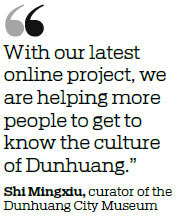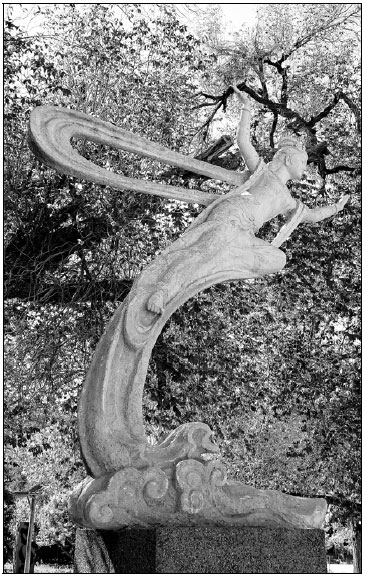Fashionable method to honor cultural heritage
LANZHOU - Imagine visiting the ancient grottoes in Northwest China's Gansu province. You are met with fairies floating in the clouds and a magical, nine-colored deer running through the air.
Now imagine them all on a swimsuit.
A design team recently introduced these elements from ancient Chinese folklore into the fashion world, with iconography from the grotto frescos such as flying fairies and the nine-colored deer featured on swimsuits and beach blouses. They have all sold out on Taobao, Alibaba's e-commerce platform.
The images of the flying apsaras can be seen in murals in Dunhuang's Mogao Grottoes, a renowned UNESCO World Heritage Site in Gansu. The site used to be a popular marketplace, travelers' stop and a religious shrine on the ancient Silk Road.
The apsaras-themed clothing, jointly developed by the Dunhuang City Museum and Taobao, has gained popularity for its cutting-edge fashion design.
It is part of a Taobao project to create innovative products based on elements from national cultural treasures.
The project connects Taobao and museums across the country to help "bring modern elements to traditional culture" and "enliven "cultural heritage.
Haoqisimi, the vendor that sells the swimsuits on Taobao, said that every detail of the swimsuits and blouses display the ancient culture of Dunhuang.
"For example, the wavy colors on the right side of the blouse are typical of Dunhuang murals," said the vendor.
It is not the first time for the museum to set foot in the field of cultural and creative products.

The museum curator, Shi Mingxiu, said that his team had worked with luxury brand Hermes to create a variety of high-end products in the past. These products were mainly sold in brick-and-mortar stores.
"With our latest online project, we are helping more people to get to know the culture of Dunhuang," Shi said. "E-commerce platforms have huge data flows, which can help spread the word much faster and wider than traditional stores."
Kou Zhong, with the Taobao project, said that they plan to develop many more products to allow natural treasures to be "closer to the public", particularly young people.
In the past few months, the project introduced innovative products, such as mini-sculptures featuring the Terracotta Warriors in Shaanxi province, facial masks based on the "face-changing" technique of Sichuan Opera, and chairs related to the Five-hundred-meter Aperture Spherical Telescope, the world's largest single-dish radio telescope, in southwestern Guizhou province.
"We incorporated design, spinoff products and supply chains, just to expand the market," said Zheng Zhong from Taobao's marketing department.
In recent years, an increasing amount of intellectual property with Chinese cultural elements has flooded the creative cultural industry.
The Palace Museum's lipstick launched last December, for instance, was popular with young people. This was due to its design inspired by the cultural relics in the museum. Sales of the lipstick, chairs and skin care products have skyrocketed.
"Upon the release of the swimsuit, more products will follow," Shi from the Dunhuang City Museum said.
"Our products may even extend to decorative materials, such as tiles featuring the lotus pattern, which is commonly seen in the Dunhuang murals."
Xinhua
|
A statue of Feitian, or flying goddess at Dunhuang's Mogao Grottoes, a UNESCO World Heritage Site in Gansu province. The image of the flying apsaras in murals at Mogao Grottoes has inspired fashion design. Provided to China Daily |
(China Daily 07/25/2019 page17)















